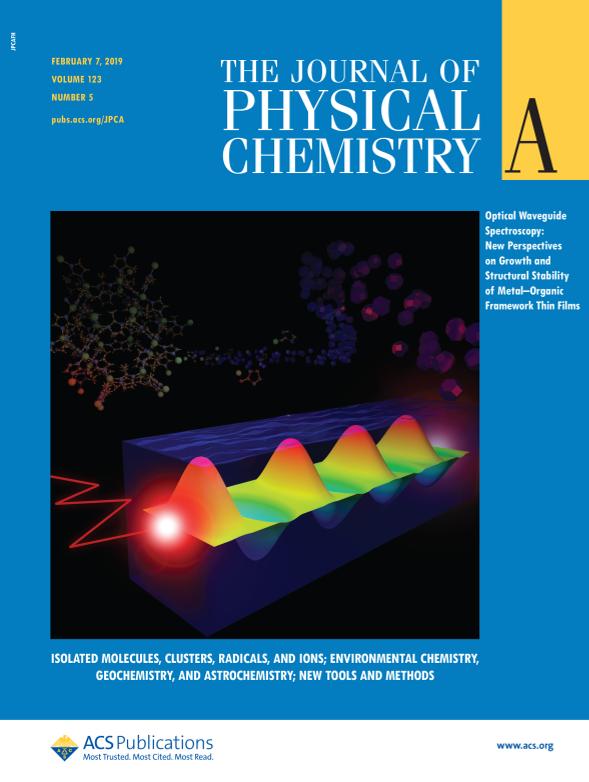Mostrar el registro sencillo del ítem
dc.contributor.author
Allegretto, Juan Alejandro

dc.contributor.author
Dostalek, Jakub
dc.contributor.author
Rafti, Matias

dc.contributor.author
Menges, Bernhard
dc.contributor.author
Azzaroni, Omar

dc.contributor.author
Knoll, Wolfgang
dc.date.available
2020-03-20T18:33:36Z
dc.date.issued
2018-11
dc.identifier.citation
Allegretto, Juan Alejandro; Dostalek, Jakub; Rafti, Matias; Menges, Bernhard; Azzaroni, Omar; et al.; Shedding Light on the Dark Corners of Metal-Organic Framework Thin Films: Growth and Structural Stability of ZIF-8 Layers Probed by Optical Waveguide Spectroscopy; American Chemical Society; Journal of Physical Chemistry A; 123; 5; 11-2018; 1100-1109
dc.identifier.issn
1089-5639
dc.identifier.uri
http://hdl.handle.net/11336/100438
dc.description.abstract
Metal-organic framework (MOF) thin films are promising materials for multiple technological applications, such as chemical sensing. However, one potential limitation for their widespread use in different settings is their stability in aqueous environments. In the case of ZIF-8 (zeolitic imidazolate framework) thin films, their stability in aqueous media is currently a matter of debate. Here, we show that optical waveguide spectroscopy (OWS), in combination with surface plasmon resonance (SPR) spectroscopy, offers a convenient way for answering intriguing questions related to the stability of MOF thin films in aqueous solutions and, eventually provide a tool for assessing changes in MOF layers under different environmental conditions. Our experiments relied on the use of ZIF-8 thin films grown on surface-modified gold substrates, as optical waveguides. We have found a linear thickness increase after each growing cycle and observed that the growing characteristics are strongly influenced by the nature of the primer layer. One of our findings is that substrate surface modification with a 3-mercapto-1-propanesulfonate (MPSA) primer layer is critical to achieve ZIF-8 layers that can effectively act as optical waveguides. We observed that ZIF-8 films are structurally stable upon exposure to pure water and 50 mM NaCl solutions but they exhibit a slight swelling and an increase in porosity probably due to the permeation of the solvent in the intergrain mesoporous cavities. However, OWS revealed that exposure of ZIF-8 thin films to phosphate-buffered saline solutions (pH 8) promotes significant film degradation. This poses an important question as to the prospective use of ZIF-8 materials in biologically relevant applications. In addition, it was demonstrated that postsynthetic polyelectrolyte modification of ZIF-8 films has no detrimental effects on the structural stability of the films.
dc.format
application/pdf
dc.language.iso
eng
dc.publisher
American Chemical Society

dc.rights
info:eu-repo/semantics/openAccess
dc.rights.uri
https://creativecommons.org/licenses/by-nc-sa/2.5/ar/
dc.subject
MOF
dc.subject
ZIF-8
dc.subject
OWS
dc.subject
SPR
dc.subject.classification
Físico-Química, Ciencia de los Polímeros, Electroquímica

dc.subject.classification
Ciencias Químicas

dc.subject.classification
CIENCIAS NATURALES Y EXACTAS

dc.title
Shedding Light on the Dark Corners of Metal-Organic Framework Thin Films: Growth and Structural Stability of ZIF-8 Layers Probed by Optical Waveguide Spectroscopy
dc.type
info:eu-repo/semantics/article
dc.type
info:ar-repo/semantics/artículo
dc.type
info:eu-repo/semantics/publishedVersion
dc.date.updated
2020-03-16T14:03:48Z
dc.journal.volume
123
dc.journal.number
5
dc.journal.pagination
1100-1109
dc.journal.pais
Estados Unidos

dc.journal.ciudad
Washington
dc.description.fil
Fil: Allegretto, Juan Alejandro. Consejo Nacional de Investigaciones Científicas y Técnicas. Centro Científico Tecnológico Conicet - La Plata. Instituto de Investigaciones Fisicoquímicas Teóricas y Aplicadas. Universidad Nacional de La Plata. Facultad de Ciencias Exactas. Instituto de Investigaciones Fisicoquímicas Teóricas y Aplicadas; Argentina. Universidad Nacional de San Martín; Argentina
dc.description.fil
Fil: Dostalek, Jakub. Austrian Institute Of Technology; Austria
dc.description.fil
Fil: Rafti, Matias. Consejo Nacional de Investigaciones Científicas y Técnicas. Centro Científico Tecnológico Conicet - La Plata. Instituto de Investigaciones Fisicoquímicas Teóricas y Aplicadas. Universidad Nacional de La Plata. Facultad de Ciencias Exactas. Instituto de Investigaciones Fisicoquímicas Teóricas y Aplicadas; Argentina
dc.description.fil
Fil: Menges, Bernhard. Resonant Technologies GmbH; Alemania
dc.description.fil
Fil: Azzaroni, Omar. Consejo Nacional de Investigaciones Científicas y Técnicas. Centro Científico Tecnológico Conicet - La Plata. Instituto de Investigaciones Fisicoquímicas Teóricas y Aplicadas. Universidad Nacional de La Plata. Facultad de Ciencias Exactas. Instituto de Investigaciones Fisicoquímicas Teóricas y Aplicadas; Argentina
dc.description.fil
Fil: Knoll, Wolfgang. Austrian Institute Of Technology; Austria
dc.journal.title
Journal of Physical Chemistry A

dc.relation.alternativeid
info:eu-repo/semantics/altIdentifier/url/http://pubs.acs.org/doi/10.1021/acs.jpca.8b09610
dc.relation.alternativeid
info:eu-repo/semantics/altIdentifier/doi/http://dx.doi.org/10.1021/acs.jpca.8b09610
Archivos asociados
